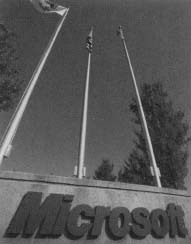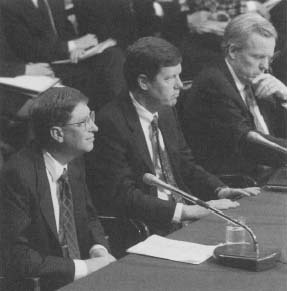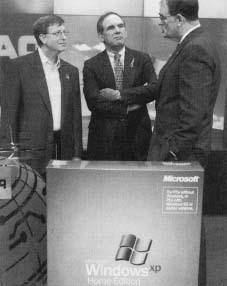Microsoft Corporation
One Microsoft Way
Redmond, WA 98052-6399
(42S) 882-8080
www.microsoft.com

Many companies make personal computers, but just one business—Microsoft Corporation—dominates the development of the software that runs on those machines. Microsoft built its success on its operating systems, the programs that control a computer's different functions and act as the "middlemen" between the machine's hardware and software. From there, the company began producing its own software programs, then expanded into the Internet and other forms of communication.
Along with success, Microsoft earned a reputation for ruthlessly trying to control the computer market. The quest for domination reflected the drive of the company's cofounder and leader, Bill Gates. Intelligent and impatient, Gates's success with Microsoft made him the richest person in the world. Gates and his company, however, have drawn loud criticism for their practices and faced several lawsuits.
Altair Leads the Way
In December 1974, Paul Allen and Bill Gates, two longtime friends from Seattle, Washington, read about a new computer that came in a kit, called the Altair 8800. The Altair was one of the first microcomputers—what are now called personal computers, or PCs. Gates later wrote in his 1995 book The Road Ahead, "Paul and I didn't know exactly how [the Altair] would be used, but we were sure it would change us and the world of computing."
Allen and Gates had already worked with BASIC, a simple programming language created in 1964. The two friends decided to create a version of BASIC that would run on the Altair, which used a new microprocessor built by Intel. (A microprocessor, or chip, is a collection of transistors and other tiny electrical parts that act as the "brain" of any personal computer.) Allen and Gates contacted MITS, the Albuquerque, New Mexico, company that made the Altair. They told MITS they had already developed a form of BASIC to run on the new computer. When MITS expressed interest in the product, Allen and Gates had to actually create the language they claimed already existed.
At the time, Gates was a sophomore at Harvard University. Allen, almost three years older, was working in Boston for Honeywell. They worked around the clock to create the new BASIC language, which MITS bought. In July 1975, Gates and Allen officially formed MicroSoft (later dropping the hyphen), which stood for "microcomputer software." It was the first company specifically founded to design software for personal computers.
Microsoft at a Glance
- Employees: 47,600
- Chairman: Bill Gates
- CEO: Steve Ballmer
- Subsidiaries: MSNBC Cable, LLC; MSNBC Interactive News, L.L.C.; WebTV Networks, Inc.; Wireless Knowledge, L.L.C; SOFTIMAGE, Inc.; Mobimagic Company Ltd.; Vermeer Technologies, Inc.
- Major Competitors: Oracle Corporation; Computer Associates International, SAP AG; Veritas Software Corporation; Siebel Systems; SOFTBANK Corporation
- Notable Products: Operating systems: Windows XP, Windows CE; Applications: Word, Access, Excel, Powerpoint, Visual BASIC, Internet Explorer; Office XP business suite; Xbox video console; Sidewinder joystick; Intellimouse
By early 1977, the company had four other programmers. At first, Microsoft's only customer was MITS. Soon, however, other companies began building computers that used the Intel microprocessor. Allen and Gates designed new versions of BASIC to sell to these companies. Microsoft earned a royalty, or fee, for every computer sold with BASIC installed. In 1978, Microsoft's sales reached more than $1 million. The company had a deal to sell its products in Japan, and this provided about half of that revenue.
MS-DOS and IBM
As Microsoft grew, Gates asked a friend from college, Steve Ballmer, to help run the business. Ballmer insisted the company needed more employees. Gates resisted at first, but finally relented, telling Ballmer to "keep hiring smart people as fast as you can, and I will tell you when you get ahead of what we can afford." Since Microsoft grew so quickly, Ballmer never had to stop hiring.
Timeline
- 1975:
- Bill Gates and Paul Allen form Microsoft to develop software for personal computers.
- 1978:
- Microsoft opens its first international sales office, in Japan.
- 1981:
- IBM sells the first personal computer using the Microsoft Disk Operating System (MS-DOS).
- 1983:
- Allen resigns from Microsoft.
- 1985:
- Microsoft introduces its first version of the Windows operating system.
- 1987:
- Microsoft Bookshelf is the company's first product on CD-ROM.
- 1990:
- Microsoft becomes the first software company to reach annual sales of $1 billion.
- 1995:
- The MSN on-line service begins operation.
- 1996:
- NBC and Microsoft begin broadcasting on the MSNBC cable network.
- 1998:
- The U.S. Justice Department accuses of Microsoft of violating antitrust laws; three years later, the company reaches a settlement with the federal government but still faces a lawsuit from nine states.
- 2001:
- Microsoft enters the video game industry with the Xbox video console.
By the time Ballmer joined Microsoft, the company had moved to Bellevue, Washington, just outside Seattle. Sales at the company were doubling each year, as more people saw the value of microcomputers, and more companies selling the computers used Microsoft BASIC. In the summer of 1980, International Business Machines (IBM), the world's leader in large mainframe computers, decided to enter the market for small, desktop computers. IBM turned to Microsoft for its programming languages and another company, Digital Research, for an operating system.
When its deal with Digital Research fell through, IBM asked Microsoft to provide an operating system. Microsoft agreed, even though it had never designed one before. Working with a tight schedule, Microsoft bought a system from a local developer, then devoted about one-third of its staff to improving it. By the summer of 1981, Microsoft had a new product: MS-DOS, which stood for Microsoft Disk Operating System.
IBM called its microcomputer the PC, for personal computer. Soon other computer companies began selling personal computers that were compatible with IBM's and used the MS-DOS operating system. Although customers could also choose another operating system, MS-DOS was cheaper, and some software companies sold programs that only ran on it. A poll taken in 1984 showed that about 80 percent of PC owners used MS-DOS. By then, Microsoft was also designing its own software for the IBM machines. Its first word processing program, Word for MS-DOS 1.0, appeared in September 1983; the company also had a popular game, Flight Simulator.
From the beginning, Microsoft employees worked long hours, and Gates sometimes slept on the floor of his office. The demanding schedule continued even as Microsoft grew. In 1984, Gates told Fortune, "You have to be in good physical condition to work here." Microsoft programmers were known to spend long stretches in their office, eating only junk food and never seeing the sun.
Windows on the Computing World
In 1983, Apple Computer, Inc. (see entry) introduced Lisa, a computer that featured a graphical user interface (GUI). GUI used images to represent software programs. Instead of typing in commands to open a program, users moved a mouse to point at and click on an icon, or picture, that represented the program. Microsoft was already working on its own GUI operating system, which it called Windows. The company officially announced the development of Windows in November 1983, after Apple had already demonstrated the power of GUI.
Microsoft, however, needed two more years to finish Windows, a delay that shook the company's reputation. When Windows finally appeared, it ran slowly, and few companies offered software that could run with it. Eventually, however, after several improvements, Windows became the standard operating system for PCs. By 1989, Microsoft sold more than two million copies.
While developing Windows, Microsoft continued to offer new software programs. It worked with Apple to create software for the Macintosh, the highly successful machine released after the Lisa. In 1985, Microsoft introduced the spreadsheet Excel. A spreadsheet is a program that calculates relations between numbers; businesses typically use it to track credits (amounts taken in) and debits (amounts owed). Lotus dominated the spreadsheet market with its 1-2-3, but Excel for Macintosh, and later Windows, became the top spreadsheet program.
The year 1985 also saw Microsoft move to its newly-built headquarters, a large campus-style complex in Redmond, Washington. In 1986, Microsoft offered shares to the public for the first time, raising $61 million for the company. Over time, Allen and Gates's stock holdings made them billionaires. Many Microsoft employees became millionaires because of the shares they owned.
Trying to Take a Bite out of Apple
Although Microsoft and Apple Computer, Inc. sometimes worked together, the two companies had their difficulties. In 1988, Apple sued Microsoft, claiming it had borrowed the "look and feel" of its operating system for Windows. Microsoft won the case, but to many Apple users, Bill Gates and company remained the enemy. Given those feelings, the computer world was stunned in 1997 when Apple cofounder Steve Jobs (see Apple entry) announced a new deal between his company and Microsoft. Gates decided to buy a small share of Apple, giving the computer company $150 million.
In 1987, Microsoft introduced its first product on CD-ROM, Microsoft Bookshelf. The disc contained ten different reference tools. Two years later, the company began selling Office, a combination of several software programs—called a "suite"—geared to businesses. These programs were often bundled, or sold with new computers, but Microsoft also focused on selling individual software programs through retail stores.

New Fields to Conquer
In 1990, Microsoft's new version of Windows, 3.0, generated fast sales, with as many as thirty thousand copies sold every week. That same year, Microsoft became the world's first software company with annual sales over $1 billion. The company continued to improve its existing products and develop new ones. With the expansion of the Internet, Microsoft introduced a browser, Internet Explorer (IE), which came packaged with Windows. Through the 1990s, Microsoft continued this strategy of adding software to Windows. Since almost all PCs came with Windows, consumers ended up with the other Microsoft software as well.
In 1995, Microsoft took a larger role in the Internet when it launched the Microsoft Network (MSN). It was designed to compete with America Online (see AOL Time Warner entry), the largest network offering e-mail, special features, and access to the Internet. MSN enrolled more than five hundred thousand customers in just a few months and had eight million users by 2002. The desire for faster access to the Internet led to the development of cable modems, which used cable TV systems to transport digital information. Microsoft entered this field in 1997 when it bought a share of cable company Comcast for $1 billion.
Another Internet/television marriage came in 1997, when Microsoft bought WebTV for $425 million. The company offered Internet access through a special device attached to a television and phone line. Most consumers, however, preferred to access the Internet through computers. As a result, WebTV was one of Microsoft's less successful purchases.
Legal Battles
In a 1997 survey, Americans named Microsoft the most respected company in America. And thanks to the PC explosion, Microsoft's products were used in millions of homes and offices every day. But within the computer industry, the company and its chairman, Bill Gates, were not so well loved. Microsoft was accused of using unfair practices to squash competitors. Gates, however, said Microsoft was not doing anything unethical. He told Business Week in 1993, "Our success is based on one thing: good products."
Disorder in the Court
During the first Microsoft antitrust trial, Bill Gates did not testify in person for his company. Instead, he appeared on videotape, answering questions at a deposition, a legal hearing conducted outside of a courtroom. Gates seemed stiff on the tape, and his decision not to appear in court struck some people as arrogant. The judge at the trial, Thomas Penfield Jackson, later compared Gates to the former self-proclaimed emperor of France, Napoleon Bonaparte (1769-1821).
When attorney generals from nine states and the District of Columbia reintroduced the lawsuit in 2002, Gates did take the stand. According to a report in the Los Angeles Times, he testified that the states' request would "cripple Microsoft as a technology company."
The same year, however, the U.S. Justice Department took over an investigation of Microsoft's marketing practices. This followed an earlier inquiry by the Federal Trade Commission (FTC) into possible illegal dealings between the company and IBM. In 1994, Microsoft agreed to end some of the practices the government said restricted competition, but the agreement was not officially settled until August 1995. In the meantime, the Justice Department filed suit to stop Microsoft's purchase of Intuit, maker of Quicken, a popular financial program.
In November 1997, the Justice Department filed another suit against Microsoft. The company was charged with illegally forcing computer makers to offer Internet Explorer in order to receive Windows 95 for their machines. The battle over IE mushroomed the next year when the U.S. Justice Department and the attorney generals of twenty states accused the company of violating antitrust laws. These laws are meant to keep one company from having a monopoly, or sole control of prices and products, in any one industry. The antitrust case dragged on until 2001, when at one point a federal judge ruled that Microsoft should be split in two.
The Justice Department, however, said it did not want to take that action and called for a quick settlement of the case. Microsoft was not forced to break up, but it did face stiff penalties for its marketing methods. Several state attorney generals did not accept the outcome and pursued the antitrust lawsuit into 2002.

Still on Top, Still Growing
Despite its legal problems, Microsoft continued to grow and dominate the software industry. In 2000, Gates gave himself a new title—chief software architect—while Steve Ballmer took over as CEO and president. The company explored new ways of connecting computer users and sharing data through a new project called. NET. And, starting in December 2000, Microsoft went on a buying spree, paying more than $1 billion apiece for three smaller software firms. The company also entered the video game market in 2001 with its Xbox console, designed to compete with such major video-game manufacturers as Sony and Nintendo.
Microsoft continued to irritate some consumers and computer experts by introducing new products that needed constant updates to work properly and ensure security. By 2002, the Internet featured hundreds of Web sites attacking Microsoft, its products, and Gates. But revenues that year were more than $27 billion, and the company had more than $38 billion in cash available for investments and research. Microsoft's influence on the lives of computer users was in no danger of weakening.
Comment about this article, ask questions, or add new information about this topic: